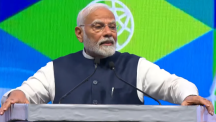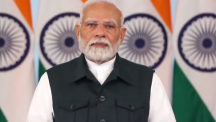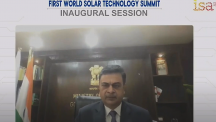Snapshot
Creating a Sustainable World
India is the 3rd largest energy consuming country in the world.
India stands 4th globally in Renewable Energy Installed Capacity (including Large Hydro), 4th in Wind Power capacity & 5th in Solar Power capacity (as per REN21 Renewables 2024 Global Status Report).The country has set an enhanced target at the COP26 of 500 GW of non-fossil fuel-based energy by 2030. This has been a key pledge under the Panchamrit. This is the world's largest expansion plan in renewable energy.
India’s installed non-fossil fuel capacity has increased 396% in the last 8.5 years and stands at more than 211.39 GW (including large Hydro and nuclear), about 46.5% of the country’s total capacity (as of Sep 2024). India saw the highest year-on-year growth in renewable energy additions of 9.83% in 2022. The installed solar energy capacity has increased by 30 times in the last 9 years and stands at 92.19 GW as of Oct 2024. India’s solar energy potential is estimated to be 748 GWp as estimated by National Institute of Solar Energy (NISE). The installed Renewable energy capacity (including large hydro) has increased by around 128% since 2014.
Up to 100% FDI is allowed under the automatic route for renewable energy generation and distribution projects subject to provisions of The Electricity Act 2003.
For further details, please refer, FDI Policy
- X+
Increase in Solar Power installed capacity from 2.6 GW to 92.19 GW since 2014
- X+
Increase in Wind capacity from 21 GW to now at 47.71 GW since 2014
- %
India's share in total installed capacity
India ranks 4th globally for total renewable power capacity additions
India has already achieved its target of 40% installed electric capacity from non-fossil fuels on Nov 2021 itself
India ranks 4th in Wind Power Capacity and 5th in Solar Power Capacity globally.
- Industry Scenario
- FOREIGN INVESTMENT
- INDUSTRY TRENDS
- POLICIES & SCHEMES
Industry Scenario
Renewable energy sources have a combined installed capacity of 203+ GW.
As of Oct 2024, Renewable energy sources, including large hydropower, have a combined installed capacity of 201.45 GW.
The following is the installed capacity for Renewables:
- Wind power: 47.71 GW
- Solar Power: 92.19 GW
- Biomass/Co-generation: 10.72 GW
- Small Hydro Power: 5.07 GW
- Waste To Energy: 0.60 GW
- Large Hydro: 46.96 GW
India has set a target to reduce the carbon intensity of the nation’s economy by less than 45% by the end of the decade, achieve 50 percent cumulative electric power installed by 2030 from renewables, and achieve net-zero carbon emissions by 2070. India aims for 500 GW of renewable energy installed capacity by 2030.
India aims to produce 5 Mn Tonnes of green hydrogen by 2030. This will be supported by 125 GW of renewable energy capacity.
50 solar parks with an aggregate capacity of 37.49 GW have been approved in India. Wind Energy has an off-shore target of 30 GW by 2030, with potential sites identified.
Following list of activities in renewable energy will be considered for trading carbon credits under bilateral/ cooperative approaches under Article 6.2 mechanism as assigned under the National Designated Authority for the Implementation of the Paris Agreement (NDAIAPA):
- Renewable energy with storage (only stored component)
- Solar thermal power
- Off-shore wind
- Green Hydrogen
- Tidal energy, Ocean Thermal Energy, Ocean Salt Gradient Energy, Ocean Wave Energy and Ocean Current Energy
- High Voltage Direct Current Transmission in conjunction with the renewable energy projects
- Green Ammonia
Union Budget 2024 Highlights
- In the Union Budget 2024-25, The Centrally Sponsored Scheme for Solar Power (Grid) has been allocated INR 10,000 Cr, an increase of 110% from INR 4,757 Cr allocated in the Union Budget 2023-25.
- PM-Surya Ghar Muft Bijli Yojana, launched in February 2024 with an outlay of INR 75,000 Cr, has been allocated INR 6,250 Cr.
- Exemption of Basic Customs Duty (BCD) on imports of 25 critical minerals important for the renewable energy sectors has also been announced.
GROWTH DRIVERS
Government commitments
Reduce India’s total projected carbon emission by 1 Bn tonnes by 2030, reduce the carbon intensity of the nation’s economy by less than 45% by the end of the decade, and achieve net-zero carbon emissions by 2070.
Proposed solar cities and parks
Solar city per state-approved and approved setting up 57 solar parks of 39.28 GW across the nation. The government is also giving a push to Floating PV Projects.
National Green Hydrogen Mission
The Union Cabinet approved the National Green Hydrogen Mission with a total initial outlay of INR 19,744 Cr, including an outlay of INR 17,490 Cr for the SIGHT programme, INR 1,466 Cr for pilot projects, INR 400 Cr for R&D, and INR 388 Cr towards other Mission components.
Off-shore Wind Energy
The medium and long-term targets for off-shore wind power capacity additions are 5 GW by 2022 and 30 GW by 2030.
Wind-Solar Hybrid Policy
In 2018, national policy was announced to promote an extensive grid-connected wind-solar PV hybrid system for efficiently utilizing transmission infrastructure and land. A way to address the intermittency challenge of one renewable power source is to combine solar and wind, achieving better grid stability. It provides flexibility in a share of wind and solar components in the hybrid project; however, the capacity of one resource must be at least 25% of the rated power capacity of other resources.
AatmaNirbhar Bharat
PLI scheme in Solar PV manufacturing with financial outlays of INR 24,000 Cr introduced under AatmaNirbhar Bharat. Imposition of Basic Customs Duty of 25% on Solar Cell & 40% on Solar PV Modules w.e.f. 01.04.2022.


Production Linked Incentive (PLI) Scheme
The Union Cabinet chaired by the Prime Minister, Shri Narendra Modi has given its approval to introduce the Production-Linked Incentive (PLI) Scheme in High Efficiency Solar PV Modules for Enhancing India’s Manufacturing Capabilities and Enhancing Exports – Aatmanirbhar Bharat. 1. The national programme on ‘high-efficiency solar PV modules’: Tranche 1: INR 4500 Cr ($550 Mn) Tranche 2: INR 19,500 Cr ($2.37 Bn). The second phase, launched on 21st Sept 2022, is expected to build 65 GW of annual manufacturing capacity. 2. National Green Hydrogen Mission with an outlay of INR 19,744 Cr ($2.4 Bn) targets 5 MMT annual green hydrogen/ ammonia production by 2030. Investors can place their bids till 7th September 2023 to seek incentives. The scheme focuses on Direct employment of about 30,000 and Indirect employment of about 1,20,000 persons; Import substitution of around INR 17,500 Cr every year, and Impetus to Research & Development to achieve higher efficiency in solar PV modules.
INR 24,000 Cr
Scheme Outlay














